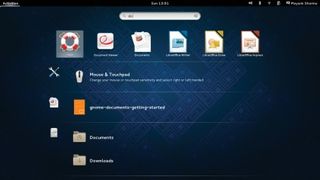Fedora 19 vs Korora 19: which is the best distro for you?
Battle of the Linux distros
The Gnome Online Accounts app can now connect to your Google, Facebook, Windows Live, Microsoft Exchange account as well as an ownCloud server. In addition to Gnome Online Accounts, Korora 19 also includes the ownCloud desktop client.
While Fedora 19, like always, has opted to implement a stock Gnome Shell, Korora 19 has tweaked it somewhat to make it more user friendly. So unlike Fedora 19 which has a very bland desktop with no icons, you get the ability to place icons on the desktop in Korora 19.
Then there's Gnome's Nautilus file manager, now known as Files. Under Fedora, it uses the Sushi file pre-viewer and has a very limited right-click context menu. However, in Korora 19 Files uses the gloobus-preview which renders previews faster than Sushi and features a meatier context menu that's hooked up to Deja Dup backup tool.
Also, the user menu in Korora 19 displays the Suspend option along with the Power Off option and ships with the Gnome Tweak Tool for modifying the advanced settings in Gnome 3. Due to these tweaks, Korora 19 presents a more usable desktop than Fedora 19.
If you're looking for drivers for your fancy graphics card or codecs to play patent-encumbered files in Fedora 19, you're barking up the wrong tree. Fedora by design avoids bundling any proprietary or non-FOSS component. So along with LibreOffice, Firefox, Shotwell, Rhythmbox, and Totem video player you get the satisfaction of running a libre desktop.
But if you lack the morals of a free software purist, that is to say you are a regular desktop user, Korora 19 is designed for you. It has full multimedia support which includes equipping Firefox with plugins to play Flash and Java content along with the VLC media player, and the Jockey device manager to handle proprietary drivers.
The applications

Unlike Fedora 19's live ISO for the Gnome desktop which weighs in at 919MB, Korora 19 Gnome ISO is 1.8GB. The distro uses the extra space to pack in popular apps for every desktop task imaginable. Firefox has the Adblock plugin and the DownloadThemAll download manager. There's also Audacity audio editor, OpenShot video editor, Handbrake video transcoder, GIMP image editor, RawTherapee for processing RAW images, Gwibber microblogging client, Liferea news aggregator and more.
Get daily insight, inspiration and deals in your inbox
Get the hottest deals available in your inbox plus news, reviews, opinion, analysis and more from the TechRadar team.
Now remember that all this software can be installed on a stock Fedora release as well, by installing repositories, such as RPMFusion. But you get them pre-installed with Korora along with custom repositories, such as Chrome, Adobe, and VirtualBox.
Another key difference between Fedora 19 and Korora 19 are their package managers. Fedora 19 includes the software front-end to PackageKit, which lacks the functionality of Yum Extender that's in Korora 19. There's nothing stellar in the KDE version on Fedora 19 as well. You get the Konqueror browser instead of Firefox, Calligra Office instead of LibreOffice, and multimedia duties are handed to Amarok and Dragon Player.
Korora's KDE edition also trumps Fedora's in terms of apps. Along with the Gnome editions ability to handle proprietary codecs and driver, it's got several KDE-specific apps, such as Dolphin and Krusader file managers, Choqok microblogging client, Kdenlive video editor and Kamoso webcam app.
In the grand scheme of things, Fedora 19 is best suited as an Enterprise desktop, which doesn't care much for the proprietary codecs and the latest hardware drivers. If you've a fast Internet connection and the knowhow you can take a stock Fedora 19 release and turn it into Korora 19 in a couple of hours. Or you can save yourself the trouble and just download Korora 19.
With almost two decades of writing and reporting on Linux, Mayank Sharma would like everyone to think he’s TechRadar Pro’s expert on the topic. Of course, he’s just as interested in other computing topics, particularly cybersecurity, cloud, containers, and coding.

